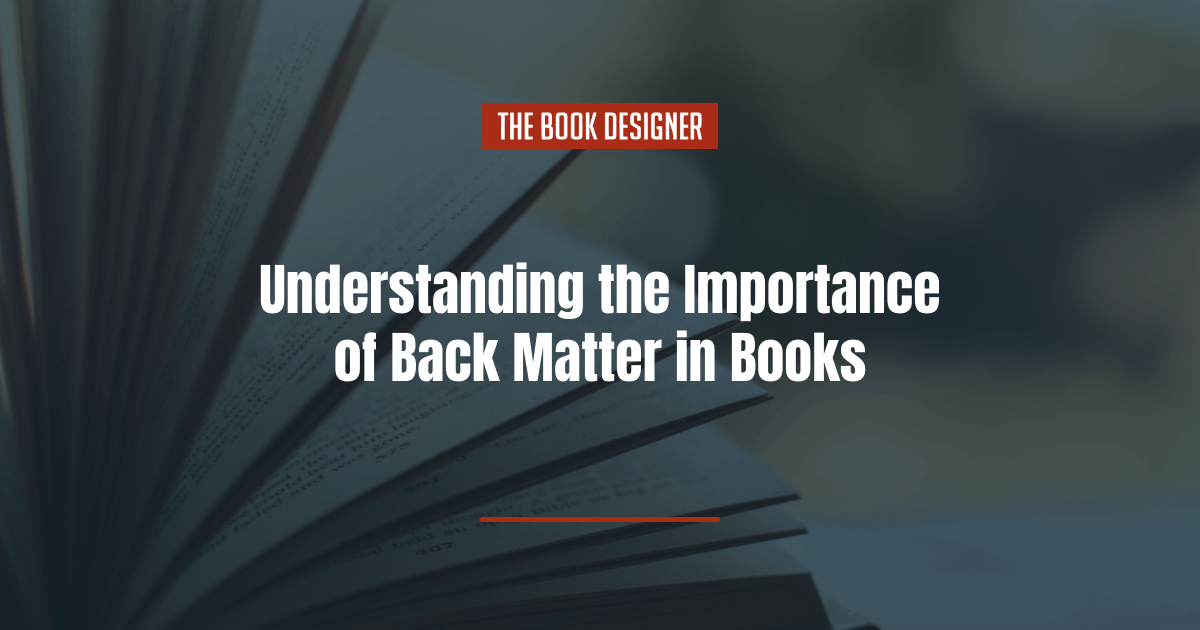When diving into the world of books, we often focus on the captivating narratives and insightful information found within their pages. Yet, there’s a hidden gem that often goes unnoticed but is equally crucial to the reader’s experience: the back matter. This often-overlooked section at the end of a book is not just filler; it’s a treasure trove of additional content that can significantly enhance the reader’s understanding and enjoyment.
In this article, we will explore the diverse elements of back matter, its importance in both fiction and non-fiction, creative uses, and how to craft effective back matter that resonates with readers. Whether you’re an avid reader, a budding author, or simply curious about the intricacies of book composition, understanding the role and potential of back matter will offer you a new appreciation for the art of book publishing.
Here’s what you need to know about creating the back matter for your book:
Types of Back Matter
- Acknowledgments: This section is a personal space for authors to express their gratitude. It may include thanks to mentors, family, publishers, and anyone who provided support or inspiration during the writing process.
- About the Author: Here, readers find insights into the author’s life, their motivations for writing, professional background, and other published works. This section often helps readers feel more connected to the author.
- Appendix or Addendum: These are for additional, often detailed, information that complements the main content. An appendix might include data tables, extended case studies, or technical details, while an addendum may feature updates or corrections to the main text.
- Glossary: Especially crucial in technical, scientific, or specialized works, a glossary defines terms that may be unfamiliar to the average reader, enhancing their understanding of the subject.
- Index: A meticulously organized index is invaluable in non-fiction books, allowing readers to quickly locate specific topics or references. It’s a detailed list of names, places, subjects, and concepts mentioned in the book, often with page numbers.
- Bibliography/References: This section lists sources, research, and literature cited or used in the book’s development. It’s essential for academic or research-focused works.
- List of Contributors: In works with multiple authors or contributors, this section acknowledges each person’s role and contributions.
- Endnotes/Footnotes: While not exclusively part of the back matter (as they can appear at the bottom of pages), endnotes are often grouped at the end of the book. They provide additional context, citations, or explanatory notes relevant to the text.
- Afterword/Postscript: This is an author’s closing remarks about the book, sometimes reflecting on the writing process, the book’s impact, or subsequent events related to the book’s content.
- Discussion Questions: Some books, particularly in educational or book club settings, include questions to prompt deeper discussion and exploration of the book’s themes.
- Teasers for Upcoming Books: Authors of series or those who have upcoming publications may include excerpts or summaries of future works to generate interest.
- Colophon: Found in some books, this section provides information about the book’s production—details about the typeface used, the paper, binding, and printing process, offering a glimpse into the physical creation of the book.
Back Matter in Fiction vs. Non-Fiction
The application and importance of back matter vary significantly between fiction and non-fiction books, each serving its audience in different ways.
In fiction, back matter is often more about deepening the reader’s connection with the author or the story. It might include:
- Author’s Note: Personal reflections or historical context related to the story.
- Discussion Questions: For book clubs or educational use, prompting readers to explore themes or characters more deeply.
- Teasers for Upcoming Books: To build anticipation for future works.
- Alternate Endings or Deleted Scenes: Offering readers a glimpse into the author’s creative process.
For non-fiction, back matter serves as an essential tool for further research and validation of the content. It typically includes:
- Index: A detailed index is crucial for readers to navigate through the content, especially in academic or reference books.
- Bibliography or References: This provides the sources of information, essential for research credibility.
- Glossary: Important for clarifying technical terms or specialized language.
- Appendices: For additional data, charts, or detailed analyses that support the main text.
In both types of books, back matter enhances the overall value of the book. In fiction, it can add layers of enjoyment and engagement, while in non-fiction, it bolsters the book’s educational and reference value.
Why Back Matter is Important
Back matter plays a critical role in enhancing the reader’s understanding and engagement with a book. For readers, it offers additional context, explanations, or resources, especially vital for complex or academic subjects. Elements like discussion questions or insights into the author’s thoughts deepen engagement, providing a more complete and satisfying experience.
From an author’s perspective, back matter is pivotal in building credibility, particularly in non-fiction works where references and indexes demonstrate thoroughness in research. It also serves as a platform for acknowledging contributions, fostering a sense of community and support. Furthermore, by including teasers or excerpts of upcoming works, authors can pique interest in their future publications.
In the broader scope of the publishing process, back matter significantly facilitates research and citation, especially in academic or professional circles. It enhances a book’s utility in libraries and bookstores, making it a more appealing reference or resource tool. Thus, back matter is not just a traditional part of book publishing but a vital component that adds depth, credibility, and value, enriching both the reader’s experience and the author’s connection with their audience.
Creative Uses of Back Matter
In the realm of book publishing, authors and publishers have been known to employ creative approaches to back matter, turning these pages into a unique and engaging part of the book. Some innovative uses include:
- Interactive Elements: In children’s books or educational materials, back matter can feature puzzles, games, or interactive questions related to the book’s content, enhancing the learning experience.
- Reader’s Guide: For fiction, especially novels that are part of book clubs, including a reader’s guide with thought-provoking questions can stimulate deeper analysis and discussion.
- Behind-the-Scenes Insights: Authors of both fiction and non-fiction may include sections detailing the inspiration behind the book, challenges faced during writing, or interesting anecdotes related to the book’s development.
- Extended World-Building: In fantasy or science fiction, additional materials like maps, lore, and histories of the fictional world can provide readers with a richer understanding of the setting.
- Author Interviews: Including an interview with the author, either conducted by another writer or a literary critic, can offer fascinating insights into the author’s thought process and creative journey.
- Fan Contributions: Some authors engage with their fan base by featuring fan art, letters, or stories in the back matter, creating a community around the book.
- Augmented Reality Features: With advancements in technology, some books include augmented reality features in the back matter, where readers can use a smartphone app to interact with the book in a multimedia experience.
- Resource Lists for Further Exploration: Particularly in non-fiction, authors can provide lists of websites, books, documentaries, or other resources for readers who wish to delve deeper into the subject matter.
Each of these creative approaches not only adds value to the book but also enhances the reader’s engagement, providing a unique and memorable experience beyond the core content of the book.
Tips for Creating Effective Back Matter
Creating effective back matter is an art that can significantly enhance the value of a book. Here are some tips for authors and publishers:
- Tailor to Your Audience: Consider what your specific readers might find valuable. In academic texts, detailed indexes and bibliographies are crucial, whereas in fiction, readers might appreciate insights into the story or characters.
- Keep It Relevant and Concise: Ensure that every piece of back matter adds value to your book. Avoid overloading this section with unnecessary content.
- Quality Over Quantity: A well-organized, meticulously edited index or glossary is more valuable than a hastily put together one. Quality in these sections reflects on the overall quality of the book.
- Engage with Extras: Think about including interviews, discussions, or even commentaries that can engage the reader further. This is particularly effective in genres like memoirs or historical fiction.
- Integrate Technology: Consider incorporating QR codes or links to online resources, making your back matter an interactive experience.
- Be Consistent with Style: The back matter should match the tone and style of the main content. A seamless transition maintains the reader’s immersion and experience.
- Consider Professional Help: Especially for complex works, hiring a professional to create your index or edit your bibliography can make a significant difference.
- Feedback and Testing: Get feedback on your back matter from beta readers or focus groups. They can provide insights into what works and what doesn’t.
By following these tips, authors and publishers can ensure that their back matter is not just an afterthought but a valuable part of the book that enhances the reader’s experience and adds to the book’s overall impact.
Final Thoughts
As we have explored, back matter is far more than just the final pages of a book; it’s a crucial component that enriches the overall reading experience. From providing additional context and resources in non-fiction to deepening the narrative connection in fiction, back matter serves a variety of important purposes.
For authors, the back matter is an opportunity to add depth to their work and engage further with their audience. For readers, it offers a more comprehensive and satisfying experience. Whether you’re writing your first novel or diving into your next reading adventure, consider the back matter not as an afterthought, but as an integral part of a book’s journey and impact.
Editor’s Note: This article was originally written by Joel Friedlander but has been expanded and updated by The Book Designer editorial team.




